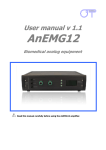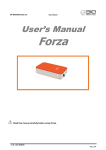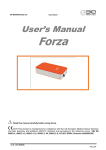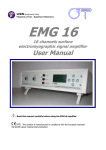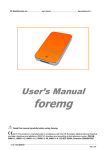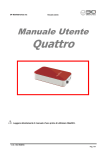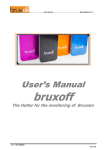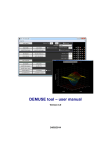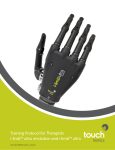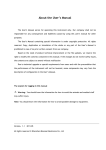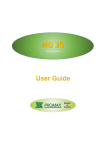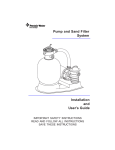Download Manuale utente EMG-USB2
Transcript
User manual v 1.1 µEMG Single channel EMG logger This product is manufactured in compliance with the European Standard 93/42/CEE about medical instrumentation, and according to the EN 60601 rules for Medical Electrical Equipment µEMG User manual pag. 2 v.1.1 µEMG User manual INDEX 1. GENERAL DESCRIPTION ...................................................................................... pag. 5 2. µEMG KIT CONTENT ............................................................................................. pag. 5 3. END USERS ........................................................................................................... pag. 5 Contraindications ............................................................................................ pag. 5 Side effects .................................................................................................... pag. 5 4. SAFETY CAUTIONS AND OTHER WARNINGS ...................................................... pag. 6 5. TECHNICAL SPECIFICATIONS .............................................................................. pag. 7 6. DETAILED DESCRIPTION ...................................................................................... pag. 8 Concentric electrode CoDe ............................................................................... pag. Status led ....................................................................................................... pag. Start/Stop button ........................................................................................... pag. MicroSD card ................................................................................................. pag. Electrode connector ....................................................................................... pag. Reference clip ................................................................................................. pag. 8 9 9 9 10 10 7. USE OF µEMG ........................................................................................................ pag. 11 Performing an acquisition ................................................................................ pag. 11 Files details .................................................................................................... pag. 11 Battery replacement ........................................................................................ pag. 12 8. µEMG MAINTENANCE AND STORAGE .................................................................. pag. 13 9. TECHNICAL CHARACTERISTICS ........................................................................... pag. 14 10. WARRANTY ........................................................................................................ pag. 15 Warranty conditions ........................................................................................ pag. 15 pag. 3 v.1.1 µEMG User manual pag. 4 v.1.1 µEMG User manual v.1.1 1. GENERAL DESCRIPTION The µEMG is a single channel EMG logger. It has been designed to detect surface electromyographic (EMG) signals, together with adhesive concentric electrode CoDe. The µEMG allows the detection and recording of the EMG signals generated by human body. The single differential signal detected by the CoDe electrode is amplified, filtered, digitally converted and then stored on a MicroSD card. A freeware software called OT BioLab has been designed by OT Bioelettronica and is available for download on the website www.otbioelettronica.it, under the download page. 2. µEMG KIT CONTENT 1 amplifier µEMG 6 electrode CoDe 4 reference electrode; 1 µEMG user manual. 3. END USER The µEMG amplifier allows non invasive recording of single differential electromyographic signals detected by surface CoDe electrode. The end user must be familiar with the EMG technique and received a proper training in EMG detection and interpretation. Contraindications The µEMG is a battery powered device and has no particular contraindications. Side effects No significant side effects are known. The materials used for manufacturing all the parts in contact with the patient are biocompatible. Possible slight cutaneous allergic reactions (e.g. skin reddening) are reduced to a minimum during short duration electromyographic signal acquisitions. pag. 5 µEMG User manual v.1.1 4. SAFETY CAUTIONS AND OTHER WARNINGS The use of the µEMG amplifier is forbidden in the following conditions: While electro surgery equipment, short waves or microwaves therapy devices are used. By mentally impaired people. Whenever the equipment is damaged. In proximity of inflammable substances (especially inflammable liquids and gases) or in environments with high concentration of oxygen. On patients carrying life-supporting equipment that might be adversely affected by electromagnetic interferences, such as pacemakers, etc. The following cautions should be observed: Only use electrodes supplied by the manufacturer: µEMG is guaranteed to achieve tested performance only if used with electrodes supplied by the manufacturer. Contact the manufacturer immediately if extraneous materials permeate into the device (liquids, powders, etc.). In case of hard shocks suffered by the µEMG (like a drop to the floor, etc.), verify that no crack or any other kind of damage of the box resulted from the shock. In case of doubt, please contact the manufacturer. The µEMG is subject to electromagnetic interference that is not dangerous for the patient (such as electrostatic or electromagnetic interference generated by electrical motors and other sources). This interference may affect the measurements of the physiological variables derived from the EMG signal. These measurements are not meant to be used for diagnostic purposes, and thus these signal alterations cannot be dangerous for the patient, please always take into account the presence of noise in your signal processing tasks and evaluations. The use of the µEMG is restricted to skilled personnel. Incorrect measurements can arise when unskilled personnel use the device in presence of strong sources electromagnetic interference (e.g. strong electromagnetic fields). The presence of interference in the signals is easily recognised by skilled personnel. pag. 6 µEMG User manual v.1.1 5. TECHNICAL SPECIFICATIONS The µEMG is a battery powered device designed to guarantee an high safety level for the patient. The signal amplified by the instrument is stored in a proprietary file format on a MicroSD card. The µEMG technical specifications are shown in table 1. Signal amplification Amplification Gain 980 V/V Bandwidth 10 Hz to 500 Hz Maximum input range 3.3 mVPP Noise level referred to input < 3 VRMS Input impedance > 1011 CMRR > 95 dB Output range 0 ÷ 3.3 V Data conversion A/D converter resolution 8 bit Storage memory MicroSD Sample frequency 1 kHz TAB. 1: µEMG technical specification pag. 7 µEMG User manual v.1.1 6. DETAILED DESCRIPTION FIG. 1 shows controls, indicators and connectors present on the µEMG and described in the following sections. 5 1 1 Concentric electrode CoDe 2 Status led 3 Start/Stop button 4 MicroSD card 5 Electrode connector 6 Reference clip 6 2 3 4 FIG. 1: µEMG description Concentric electrode CoDe The CoDe (Concentric Detection) is an adhesive disposable concentric electrode distributed by OT Bioelettronica. The CoDe electrode allows the detection of surface myoelectric signals. The geometry of the system, a point electrode and a circular ring, avoids the problem of the orientation of classic bipolar recordings. Moreover, the system transfer function approximates a double differential filter which thus provides better spatial selectivity and better reduction of crosstalk with respect to bipolar systems. The electrode is available in different sizes, depending on the specific application. The detection site is made of AgCl and the electrode connector types can be mounted depending on the needs. The CoDe electrode is the only system purely isotropic, that is invariant to rotations. Other systems, such as the Laplacian recording, approximate the isotropic condition but do not fulfill it. The isotropy eliminates the problem of electrode orientation. In addition, the system provides a two-dimensional spatial filtering with selectivity similar or higher than other systems with larger number of electrodes. The proposed system only uses two electrodes, thus it can be used with any standard bipolar amplifier, and shows a spatial selectivity comparable with the Laplacian system pag. 8 µEMG User manual v.1.1 which comprises 5 electrodes. Higher selectivity implies a lower amount of crosstalk, which is one of the main problems in surface EMG recordings. Status led The led on the µEMG indicate the device status. In table 2 the led condition and the associated status are described. Condition µEMG status Led is OFF The µEMG is switched OFF Led is ON The µEMG is in standby. No acquisition is running. Led pulses every 3 seconds The acquisition is running. Led pulses continuously The battery is low or the MicroSD not correctly formatted. It is not possible to start an acquisition. TAB. 2: µEMG status Start/Stop button The red button starts or stop the signal acquisition and the data storing on the MicroSD card. When the button is pressed a new file is created on the MicroSD card and is closed when the button is pressed again. To avoid the creation of large files the µEMG automatically close the file when it reach the dimension of 1 MByte (after about 17 minutes) and open a new file to continue the data acquisition. REMARK: Removing the MicroSD card during the signal storing will avoid the file closing. The file not closed will be displayed, on the PC browser, with a dimension of 0 kByte and it will be not possible to recover the data. MicroSD card On the left side of the µEMG there is a slot for the MicroSD insertion. The MicroSD have to be inserted with its contacts upward. In any case it is not possible to insert the card in the opposite way. Push the MicroSD to insert it and push again to release it. The insertion of the MicroSD card switch on the µEMG. Removing the MicroSD card the µEMG is switched off. Always remove the MicroSD card when the µEMG is not used to save the battery. pag. 9 µEMG User manual v.1.1 The MicroSD card must be formatted with standard FAT. Formatting the card as FAT32 or NTFS the instrument will not work and the led will pulse continuously to indicate the malfunction. REMARK: Use only MicroSD card. The HC version will not work with the µEMG. Electrode connector The CoDe electrode have to be connected at this circular connector. The portion of cable between the µEMG and the electrode connector is shielded to reduce interference coupling. Reference clip On the back side of the µEMG a clip connector has a double function. The primary function is to fix the voltage reference on the patient, the second is to keep mechanically the µEMG without the need of tapes. It is possible to use a common electrode or a reference strap to electrically connect the µEMG internal reference point with a point on the patient without EMG activity (e.g. the ankle or the wrist). pag. 10 µEMG User manual v.1.1 7. USE OF µEMG Performing an acquisition To perform an acquisition follow the steps reported here: 1. Connect the reference electrode or the reference strap to a point without EMG activity on the subject and connect the clip of the electrode with the clip on the back of the µEMG; 2. Place the CoDe on the muscle to investigate and connect the code to the µEMG; 3. Insert the MicroSD card in the µEMG slot, the led will turn on ; 4. Press once the red button to start an acquisition, the led will start to pulse every 3 seconds; 5. Press the button again, the led will stop pulses and will turn on; 6. Repeat the points 4 and 5 all the times you need; 7. Remove the MicroSD card and insert it in a card reader on a PC with OTBioLab installed; 8. Open the saved files with OTBioLab and process them. Files details The files are stored on the memory card with a standard name. The name is structured as follow: UEMG_FXY.EMG Where X is the session counter and Y is the acquisition counter. The acquisition counter is incremented every time the start/stop button is pressed. The session counter is incremented every time the MicroSD card is removed and then inserted. Since the two characters can assume the values 0, 1, 2 ... 8, 9, A, B ... Z, it means that up to 36 different files can be acquired in the same session and 36 different session can be created before to obtain two file with the same name. It is up to the user to copy the files out of the memory card and delete the files in the card to free the filenames. When a file exist on the memory card and a new one with the same name is created the file is appended to the existing file. Since the µEMG does not have an internal real time clock device, the date and time of the files will not reflect the real time in which they are generated. Although, the time and date is generated starting from the 00:00 of the January 1ST 2010 and is incremented by 1 minute at every new acquisition. Sorting the files for the date it is possible to have the file listed in the same order in which they has been created. pag. 11 µEMG User manual v.1.1 Battery replacement The µEMG works with a 12V battery MN21. The battery allows the acquisition of about 8 – 9 hours of EMG signals. When the µEMG led starts to pulse continuously it is necessary to replace the battery. To replace the battery it is necessary to open the µEMG. The µEMG has no screws, just pull the upper and bottom part of the enclosure. Remove the previous battery and put the new one. Take care about the battery polarity. The µEMG is not damaged if the battery is inserted in the opposite way but the battery can lose a large amount of charge. pag. 12 µEMG User manual v.1.1 8. µEMG MAINTENANCE AND STORAGE The µEMG has to be used in the following ambient conditions: Temperature: from 0°C to +40°C Maximum relative humidity: 75% Atmospheric pressure: from 700 hPa to 1060 hPa It is recommended to turn off the µEMG at the end of each measurement session, by removing the MicroSD card. The µEMG should be stored with all the enclosed accessories on a safe desk far from all the situations listed in the section Warnings. µEMG should be stored in the following ambient conditions: Temperature: from –20°C to +40°C Maximum relative humidity: 75% Atmospheric pressure: from 700 hPa to 1060 hPa Cleaning: use only a dry cloth to clean the device. The µEMG should be repaired by the manufacturer only. Every repair executed by unauthorized personnel will be considered as a device violation voids the manufacturer’s warranty. Disposal The device and the accessories should be disposed in compliance with the relative standards in special equipped areas or with special waste. pag. 13 µEMG User manual 9. TECHNICAL CHARACTERISTICS Model: µEMG Classification: - battery supplied device - IP50, about the penetration of fluids and dust; device not protected Case: plastic case Power supply: 12V MN21 battery Consumption: 25 mW Limitations: the device is not suitable for use in environments with high oxygen concentration and/or flammable fluids and/or gases; do not use with electro-surgery or short wave/microwave therapy equipment. Working conditions: device suitable for continuative work. Input channels: Amplifier: 1 channel Maximum input range: 3.3 mVPP Bandwidth: 10 ÷ 500 Hz Total noise (RTI) < 3VRMS Gain: 980 V/V Input impedance > 1011 on the entire bandwidth CMRR > 95 dB Commands: 1 button. Dimensions: 57 x 36 x 16 mm Weight: 25 g. pag. 14 v.1.1 µEMG User manual v.1.1 10. WARRANTY The µEMG is covered by a 24 months warranty starting from the purchasing date of the electronic parts. The warranty is void in case of device violation or in case of intervention from unauthorized staff. Warranty conditions are reported hereinafter. Warranty conditions 1. The warranty lasts 24 months on the electronic parts. Warranty is provided by the manufacturer. 2. The warranty covers only device damages that cause malfunctioning. The product must have the same serial number indicated on this certificate, or the warranty is released. 3. The warranty covers only the cost of repair or substitutions of defective components, including the costs of labour. 4. The warranty is void in case of damages caused by negligence, use not compliant with the instructions supplied, unauthorized repairs and accidental circumstances, especially for the external part. 5. The warranty is void with damages caused by incorrect power supply. 6. The warranty is not applied on all the parts subject to wear and tear. 7. The warranty does not include the shipment costs. 8. After 24 months the warranty is released. All the substituted parts, the labour costs and the shipment costs will be charged to the purchaser according to the rates in force. pag. 15 µEMG User manual Designed, produced and distributed by: OT Bioelettronica C.so Unione Sovietica 312 10135 – Torino (TO) - ITALY Tel:+39.011.6198498 Fax:+39.011.6198498 URL: www.otbioelettronica.it e-mail: [email protected] pag. 16 v.1.1



















